RELOOP MIXON4

SETUP
Firmware & Drivers
Firmware: Update the firmware of the unit to the latest version from http://www.reloop.com/reloop-mixon-4
Drivers (for Windows only): Install the latest Reloop Mixon4 ASIO drivers from http://www.reloop.com/reloop-mixon-4
No drivers are required for Mac OSX computers
VirtualDJ Setup
Once VirtualDJ 8 is launched, a Login Window will appear to enter your virtualdj.com account credentials.
A Pro Infinity or a Pro Subscription License is required to fully use the Reloop Mixon4. Without any of the above Licenses, the controller will operate for 10 minutes each time you restart VirtualDJ.
http://www.virtualdj.com/buy/index.html

Select “Use Soundcard” in order VirtualDJ to use the pre-defined audio configuration for the unit. Speakers and Headphones need to be connected to the Mixon4 in this case.
Click to OK.
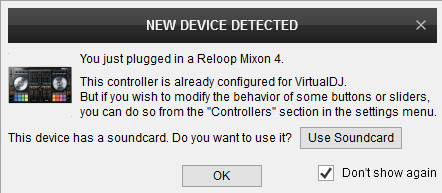
MIDI Operation
The unit should be visible in the CONTROLLERS tab of Config and the “factory default” available/selected from the Mappings drop-down list. The factory default Mapping offers the functions described in this Manual, however those can be adjusted to your needs via VDJ Script actions.
Find more details at http://www.virtualdj.com/wiki/VDJ8script.html
AUDIO Setup
The unit has a pre-defined Audio setup and a special button in the AUDIO tab of Config to provide that. When the pre-defined audio configuration is selected, speakers need to be connected to the rear Master Output connection (to the RCA or XLR sockets) and your Headphones plugged to the front Headphones socket of the Mixon4
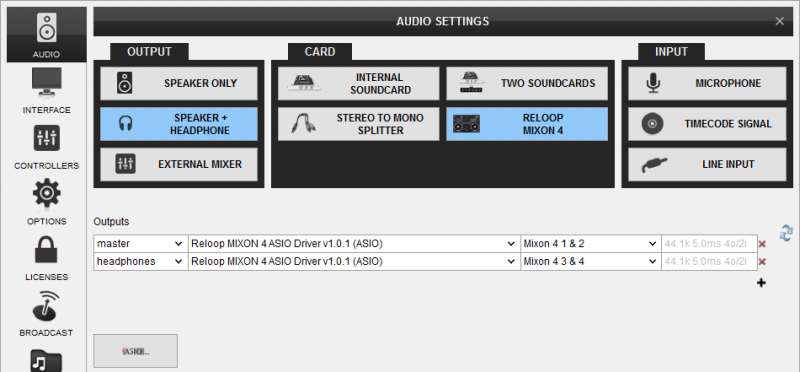
For further software settings please refer to the User Guides of VirtualDJ 8.
http://www.virtualdj.com/manuals/virtualdj8/index.html
LAYOUT

S SHIFT. Hold this button down to access secondary functions of the Reloop MIXON4
The functionality of each button and knob per section (as shown in the image below) will be explained in detail in the next chapters
A. Mixer & Browser
B. Deck Controls
C. Effects
D. Pads
E. Front & Rear panels
MIXER & BROWSER Controls

- CROSSFADER. Blends audio between the channels assigned to the left and right side of the crossfader.
- CF CURVE. Use this switch to select one of the 3 available Crossfader curves (Full, Smooth and Scratch)
- CF ASSIGN. Set a mixer channel as Left (A position), Right (B position) or Thru. When in THRU position, the crossfader will not affect the output level of the channel. When in A/B position, the output of the channel will be maximum at left/right crossfader position and its output level will be blend with the audio signal of the Right/Left assigned decks depending on the crossfader position and the selected crossfader curve.
- VOLUME. Adjust the Volume of each channel.
Hold SHIFT down and then use use these faders to adjust the Volume of each channel and at the same time stop the deck to the last Cue position, when the fader is at the minimum position and start the deck when the fader moves from the minimum position to any other. (Fader Start/Stop) - PFL/CUE. Press these buttons to send the audio signal from a mixer channel to the Headphones Output channel.
Hold SHIFT down and then use these buttons to assign a deck as Left/Right side of the Video crossfader. Hold SHIFT down and then use the same buttons to turn off all Video Crossfader Assign buttons and return to the manual assignment (VirtualDJ will automatically assign as left and right sides of the Video crossfader, the Left and Right assigned Decks) - LOAD. Press these buttons to load the selected track from the Browser to decks 1 to 4. The LED of the button will be on if the deck is loaded.
Hold SHIFT down and then press the LOAD button on Channel 3 to load the selected track to the Automix List.
Hold SHIFT down and then press the LOAD button on Channel 1 to open/close Sideview Browser window.
Hold SHIFT down and then press the LOAD button on Channel 2 to cycle through the available Mixer panels (Audio, Video, Scratch and Master).
Hold SHIFT down and then press the LOAD button on Channel 4 to cycle through the available Sideview windows (Automix, Sidelist, Karaoke, Sampler and Clones). - FILTER. Use this knob to apply a High/Low Pass Filter to the deck. In middle position no filter is applied.
The knob is also offering 2 additional Filter FX modes.
Mode 1: Use the M button to enable disable Filter FX Mode 1. In this mode the Filter knob will also trigger the selected Effect in FX Slot 1 when not in the middle position.
Mode 2. Hold SHIFT and then use the M button to enable/disable Filter FX Mode 2. In this mode the Filter knob will trigger the selected Effect in FX Slot 1 when the knob is not at the middle position, and at the same time it will control the 1st parameter of the selected Effect.
When any of the Filter FX modes is enabled, hold SHIFT and then use the knob to only apply a High/Low pass Filter without triggering the selected Effect. - EQ LOW. Adjust the Low (Bass) frequencies for each mixer channel.
- EQ MID. Adjust the Mid frequencies for each mixer channel.
- EQ HIGH. Adjust the High (Treble) frequencies for each mixer channel.
- GAIN. Adjust the Gain of each mixer channel.
- MASTER VOLUME. Adjust the level of the Master Output. Hardware operation - movement not visible on the VirtualDJ GUI
- BOOTH VOLUME. Adjust the level of the Booth Output. Hardware operation – movement not visible on the VirtualDJ GUI.
- HEAPHONES VOLUME. Adjust the Volume Output of the Headphones Channel.
- HEADPHONES MIX. Adjust how the Channels and the Master Output blend at the Headphones Channel.
- SAMPLER VOLUME. Adjust the Master Output Volume of the VirtualDJ Sampler
- BROWSE ENC. Scroll through files of folders. Push the encoder to toggle focus between the Folders and the Songs Lists.
Hold SHIFT down and then use the encoder to scroll faster (+/- 15 tracks or folders per click)
Hold SHIFT down and then push the encoder to toggle between the normal and zoomed Browser view - BACK. Use this button to set focus to the Folders List. If focus is already to the Folders List, use this button to open/close sub-folders.
Hold SHIFT down and then use this button to cycle focus between the available Browser windows (Folders, Songs and Sideview).
DECK CONTROLS
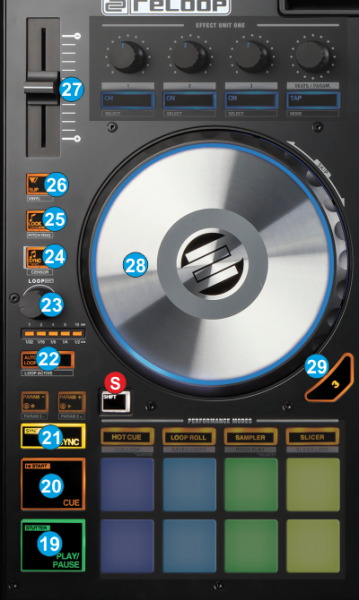
- PLAY/PAUSE. Plays / Pauses the track. Press and hold SHIFT and then press this button to play-sutter the track.
- CUE. When the Deck is paused, you can set a temporary Cue Point by moving the Platter to place the Audio Pointer at the
desired location and then pressing the Cue Button. During playback, you can press the Cue Button to return the track to this Cue Point. (If you did not set a Cue Point, then it will return to the beginning of the track.). If the Deck is paused, you can press and hold the Cue Button to play the track from the Temporary Cue Point. Releasing the Cue Button will return the track to the temporary Cue Point and pause it. To continue playback without returning to the Temporary Cue Point, press and hold the Cue Button, then press and hold the Play Button, and then release both buttons.
Press and hold SHIFT and then press this button to return to the beginning of the track. - SYNC. Press this button to automatically match the corresponding Deck's tempo with the opposite Deck's (or the Master Deck’s if using a 4 decks Skin) tempo and phase.
Hold SHIFT down and then press this button to set this deck as Master Deck. When a Deck is set as Master Deck, all other decks will sync to this deck. When SHIFT is held, the LED of the SYNC button will indicate the Master Deck. When the LED is flashing, the Master Deck is in manual mode. To return to the auto-mode selection, press the flashing SYNC button - AUTOLOOP. Use this button to enable/disable an auto-loop of the selected size in beats.
Hold SHIFT down and then use this button to enable the last triggered Loop (Re-loop) - LOOP ENC. Use this encoder to half/double the size of the loop.
The LEDs below this encoder indicate the selected loop size in beats. When the LED is solid the loop size is designated by the top silkscreen labels. When the LED is flashing, the loop size is designated by the bottom silkscreen labels.
When a loop is triggered, hold SHIFT down and then use this encoder to move backwards/forwards the loop in time by 1 beat per click. - KEY SYNC. Use this button to match the key of the deck with the one from the opposite deck.
Hold SHIFT down and then use this button to play the track in reverse while the button is pressed. When released, the track will continue playing from the position it would have been if never pressed (censor) - KEY LOCK. Use this button to lock the key of the track to the current value, and not allow that to change when the Pitch/Tempo is changed (Master Tempo)
Hold SHIFT down and then use this button to select the next available % range for the Pitch fader. - SLIP. Use this button to enable/disable the Slip mode. When enabled, several functions such as scratching, hotcues and loops will act temporary and when finished, the track will resume playing from the position it would have been if those actions never took place.
Hold SHIFT down and then use this button to enable/disable Vinyl mode. - PITCH. Controls the track's playback tempo.
When the LED is turned on, it indicates that the pitch fader of the unit is on zero (center) position and the track plays at its original speed. When the LED is flashing, the pitch values of the software and hardware don't match and you will need to move the hardware pitch fader until it reaches the software value, in order to regain hardware tempo control (soft-takeover). This can happen if you press SYNC and the tempo of the track changes to a different value. - JOGWHEEL. Touch sensitive platter for scratching (vinyl mode enabled), bending (CD Mode) or Seek mode. In Vinyl mode, use the jogwheel to scratch and the outer ring to bend.
Hold SHIFT down and then use the jogwheel to navigate through the track (seek mode) - DECK SELECT. Switch Control for the Left decks (1 and 3) and Right Decks (2 and 4).
Hold SHIFT down and then use this button to enable/disable After-Touch velocity
EFFECTS
The Reloop Mixon4 offers 2 modes for the Effects control. In the Multi Effect mode, the effect units offer control for 3 Effect slots with 2 effect parameters for each one, while the Single Effect mode offers a single Effect slot but more effect parameters. Use the SHIFT+TAP button to toggle between these 2 modes. Each time a mode is selected, the FX units of the default VirtualDJ skins will display 1 or 3 Effect Slots

- FX1 ON.
In Multi Effect mode use this button to enable/disable the selected effect of FX Slot 1.
Hold SHIFT down and then use this button to select the next available effect for FX Slot 1.
In Single Effect mode, use this button to enable/disable the selected Effect.
Hold SHIFT down and then use this button to open/close the FX GUI of the selected Effect at the right side of the Browser - FX2 ON.
In Multi Effect mode use this button to enable/disable the selected effect of FX Slot 2.
Hold SHIFT down and then use this button to select the next available effect for FX Slot 2.
In Single Effect mode, use this button to select the previous available Effect.
Hold SHIFT down and then use this button to enable/disable the 1st FX button of the selected Effect (if available) - FX3 ON.
In Multi Effect mode use this button to enable/disable the selected effect of FX Slot 3.
Hold SHIFT down and then use this button to select the next available effect for FX Slot 3.
In Single Effect mode, use this button to select the next available Effect.
Hold SHIFT down and then use this button to enable/disable the 2nd FX button of the selected Effect (if available). - FX1 knob.
In Multi Effect mode the knob controls the 1st parameter of the selected effect of FX Slot 1.
Hold SHIFT down and use this knob to adjust the 2nd parameter of the selected effect of FX Slot 1.
In Single Effect mode the knob controls the 1st parameter of the selected effect.
Hold SHIFT down and then use this knob to control the 4th parameter of the selected Effect (if available) - FX2 knob.
In Multi Effect mode the knob controls the 1st parameter of the selected effect of FX Slot 2.
Hold SHIFT down and use this knob to adjust the 2nd parameter of the selected effect of FX Slot 2.
In Single Effect mode the knob controls the 2nd parameter of the selected effect.
Hold SHIFT down and then use this knob to control the 5th parameter of the selected Effect (if available) - FX3 knob.
In Multi Effect mode the knob controls the 1st parameter of the selected effect of FX Slot 3.
Hold SHIFT down and use this knob to adjust the 2nd parameter of the selected effect of FX Slot 3.
In Single Effect mode the knob controls the 3rd parameter of the selected effect.
Hold SHIFT down and then use this knob to control the 6th parameter of the selected Effect (if available) - TAP/MODE.
Use this button to manually tap the tempo of the track (at least 4 taps while track is playing). When track is paused, use this button to set the current position as first-beat.
Hold SHIFT down and then use this button to toggle between the Single and Multi Effect modes. - BEATS ENC.
Use this encoder to manually adjust the Beat-grid of the track. Each click to the left/right direction, moves/slides the CBG pattern backwards/forward by 5% (20 clicks required to move the CBG by 1 beat)
Hold SHIFT down and then use the encoder to adjust the width of the CBG (or else the BPM of the track), starting from the first-beat.
Push the encoder to set the current position of the track as First-beat.
Hold SHIFT down and then push the encoder to re-analyze the track and cancel all manual CBG adjustments.
PADS
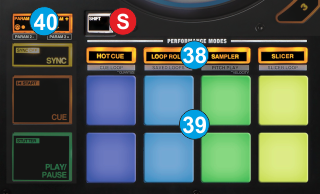
Pads (39) offer 8 different modes, depending on the PAD MODE SEL buttons (38). Press the same PAD MODE button again to access the additional mode (the LED will blink in this case).
Each time a mode is selected, a Page will be selected and displayed on the Pads section of the default VirtualDJ skin
Use the PARAMETER -/+ buttons (40) to adjust the Parameter 1 (if available) of the selected Pads page
Hold SHIFT down and then use the PARAMETER -/+ buttons (40) to adjust the Parameter 2 (if available) of the selected Pads page
HotCues mode
Press the HOTCUE mode button to set the PADs to HotCue mode (LED will be turned on). The Hotues page will be then selected and displayed on the Pads section of the VirtualDJ skin
Each one of the 8 pads assigns a Hot Cue Point (1 to 8) or returns the track to that Hot Cue Point.
When a Hot Cue Button is unlit, you can assign a Hot Cue Point by pressing it at the desired point in your track. Once it is assigned, the Hot Cue Button will light up.
Hold SHIFT and then press any of the pads to delete its assigned Hot Cue Point.
Use the PARAMETER - and + buttons (40) to jump to the next or previous HotCue.
Hold SHIFT down and then use the PARAMETER -/+buttons to jump the track forward/backwards by 1 beat
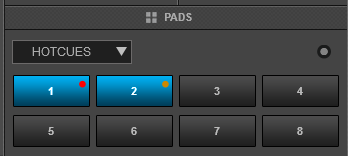
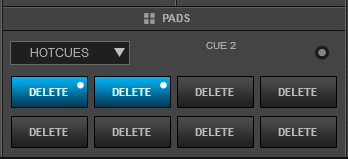
Note: By default Hotcues will get the color of the deck (blue for deck 1, red for deck 2, green for deck 3 and orange for deck 4). A different coloring behavior can be offered via the NonColoredPOI setting (from VirtualDJ Settings OPTIONS tab).
Cue-Loop mode
Press the HOTCUE Mode button twice (or once if the selected mode was HotCues) to set the Pads to HotCue Loop mode (the led of the button will flash). The CueLoop page will be then displayed on the Pads section of VirtualDJ skin
Each one of the 8 Pads assigns a Hot Cue Point or returns the track to that Hot Cue Point, but in both cases, it also triggers a momentary or toggle Loop depending on the selected mode.
The currently selected length will be used for the triggered Loop
Hold SHIFT down and then press a pad to jump to the Hot Cue Point but leave the Loop enabled.
Use the PARAMETER - and + buttons (40) to half and double the size of the applied Loop.
Hold SHIFT down and then use the PARAMETER -/+ buttons to select the On/Off (toggle) or Hold (loop will be enabled while the Pad is pressed) mode
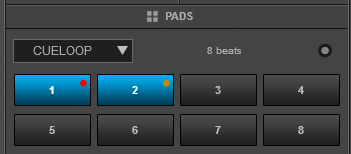
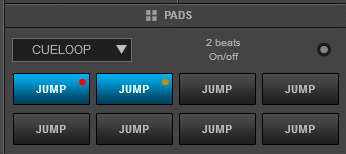
Loop Roll mode
Press the LOOP ROLL mode button to set the Pads to Loop Roll mode (LED will be turned on). The LOOP ROLL page will be then selected and displayed in the Pads section of the default VirtualDJ skins.
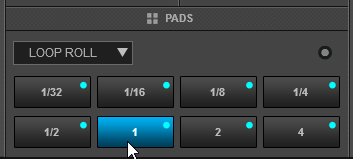
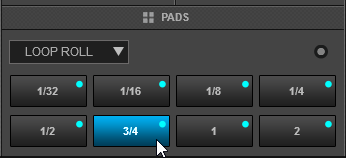
Each one of the 8 Pad triggers a momentary Loop Roll (while pressed) of a different length in beats as per the images above.
In this mode the PARAMETER (40) buttons have no functionality.
Saved Loops mode
Press the LOOP ROLL Mode button twice (or once if the selected mode was Loop Roll) to set the Pads to Saved Loops mode (the led of the ROLL button will flash). The Saved Loops page will be then selected and displayed in the Pads section of the VirtualDJ skins.
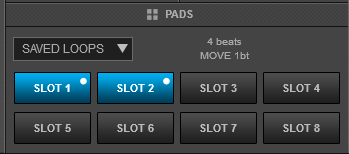
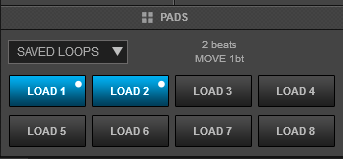
This mode offers the ability to save up to 8 Loops to individual Loop Slots.
Press any Pad to save the current Loop at the current track’s position (of the selected size in beats) to the relative slot. Hold the same Pad down for more than 1 second to delete the Saved Loop.
When a Loop slot is saved, press the corresponding Pad to load (prepare) the Saved Loop.
If the track’s position is before the Saved Loop point, the loop will be enabled but the track will not jump to that position (Prepare status). Use the same Pad to disable the Loop.
Hold SHIFT down and then press one of the lower Pads to load the Saved Loop, but also jump to that position.
Use the PARAMETER - and +(40) buttons to half and double the size of the triggered Loop.
Hold SHIFT down and then use the PARAMETER buttons to move the Loop forward/backwards by 1 beat
Sampler mode
Press the SAMPLER mode button to set the PADs to Sampler mode (LED will be turned on). The Sampler Page will be then selected and displayed in the Pads section of the VirtualDJ default skins
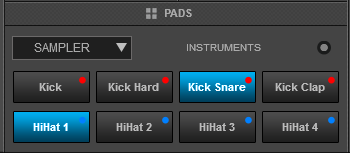
Each one of the 8 pads triggers a sample (1 to 8) from the selected Sampler Bank of VirtualDJ. If the selected Sampler Bank has less than 9 samples, both sides of the unit will trigger the same Samples. If the selected Sampler Bank has more than 8 samples, the left side of the unit will trigger Samples 1 to 8 and the right side of the unit will trigger Samples 9 too 16.
The leds of the Pads will automatically get the assigned color of each sample (dark when off, bright when playing).
Press the pads to trigger a sample. Depending on the selected trigger mode, use SHIFT and the same pads to stop the sample.
Use the PARAMETER - and + buttons (40) to select the previous and next Sampler Bank.
Hold SHIFT down and then use the same PARAMETERS buttons to select the previous/next Trigger Pad mode (on/off, hold, stutter, and unmute)
Key - HotCue mode
Press the SAMPLER Mode button twice (or once if the selected mode was Sampler) to set the Pads to Key-Cue mode (the led of the SAMPLER button will flash). The KeyCue page will be then selected and displayed in the Pads section of the VirtualDJ skins.

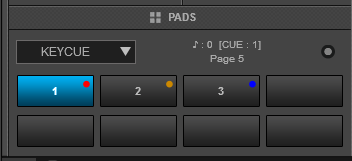
In this mode, the Pads trigger a selected Hotcue point (or the Temporary Cue if none selected or not available) at a selected Key semitone (from -7 to +7).
8 different pages/banks are offered with various semitone values to use and a 0 value (reset key to tis original value) is always offered in all pages.
Hold SHIFT and then select a Hotcue for the Key pads to trigger. Each time a Pad is pressed, the track will jump to that Hotcue point and will also alter the Key of the track to the value designated by it assigned value.
Use PARAMETER buttons -/+ to adjust the Key of the track without trigger a Hotcue.
Hold SHIFT and then use the PARAMETER buttons to select a different page/bank with different key semitone values.
Slicer mode
Press the SLICER mode button to set the PADs to Slicer mode (LED will be turned on).The Slicer Page will be then selected and displayed in the Pads section of VirtualDJ skin.
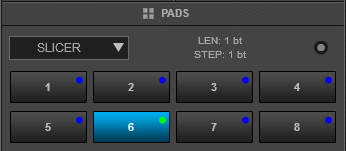

The eight pads represent eight sequential beats/Slices in the Beat Grid. The playing Slice is represented by the currently green lit pad. The green light will "move through the pads" as it progresses through each eight-Slice phrase. Press a pad to repeat that Slice (hold it down if you want to keep looping it). Once the Pad is released the track will continue to play from the position it would have been if the pad was never pressed.
Hold SHIFT button down and then use the same Pads to use the Slicer in Hold mode. In this mode, the slices are memorized (using the last triggered ones)
Use the PARAMETER - and + buttons (40) to adjust the length of the Loop applied to the slice. Press SHIFT and then use the same PARAMETERS - and + buttons to adjust the step of the Slices.
Beatjump mode
While the Slicer mode is selected, press the same SLICER mode button again to set the PADs to Beat Jump mode (led will blink). The BeatJump page will be then selected and displayed on the Pads section of the VirtualDJ skin
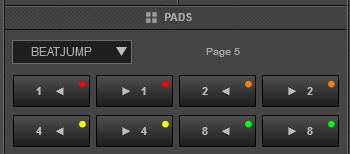
In this mode, each one of the Pads will jump the track backwards/forward by the amount of beats depending on the selected page/bank (from 1/8 beats to 32 bars)
Use the PARAMETER < > buttons to select a different bank/page with the desired size of beat jumps
Velocity mode
The Reloop Mixon4 offers both momentary and After-touch Velocity for the Pads.
The velocity can be turned on/off by holding the SAMPLER mode button for about 3 seconds. The LEDs of the Pads will momentary light up red, when velocity is turned off and will blink in green color 4 times when the velocity is turned on.
Velocity is turned on/off per Deck, meaning that a Deck can have velocity turned on while another can have it turned off.
In the factory default mapping, the extra velocity keys, are only used in the Sampler mode, assigned to control the volume of each sample, but those can also be customized and assigned in all available modes.
When velocity is enabled, in Sampler mode each one of the 8 pads triggers a sample (1 to 8) from the selected Sampler Bank of VirtualDJ, with the difference that the Output Volume of each sample is determined by the strength the Pad was initially pressed.
When the After-touch velocity is enabled, it overrides the momentary velocity and the volume of the sample is constantly controlled by the applied pressure on the Pad. The volume of the sample will go to zero once the Pad is released.
After-touch velocity can be turned on/off using SHIFT +DECK SELECT button (on by default)
FRONT & REAR PANELS

- HEADPHONES INPUT. Connect a pair of Headphones to this socket (1/4” or 1/8”). The Volume of this Output is controlled by the knob at the top panel
- MIC INPUT. Connect your 1/8” Microphone to this Input.
The Microphone Inputs is not part of the USB audio interface, therefore it can not be added to the Audio setup of VirtualDJ, neither can be controlled by the software or recorded - MIC VOL. Adjust the volume of the Microphone input signal. Hardware operation (not visible on the VirtualDJ GUI).

- MASTER OUTPUT BALANCED (XLR): Connect this low-impedance XLR output to a PA system or powered monitors. The level of this output is controlled with the Master knob on the top panel.
- MASTER OUTPUT UNBALANCED (RCA): Use standard RCA cables to connect this output to a speaker or amplifier system. The level of this output is controlled by the Master knob on the top panel.
- BOOTH OUTPUT (TRS): Use standard TRS cables to connect this output to a booth monitoring system. The level of this output is controlled by the Booth knob on the top panel.
- iOS. Use this socket to connect the MIXON4 with an iOS device. VirtualDJ does not use this connection and does not offer iOS support
- USB. This USB connection sends and receives audio and control information from a connected computer.
- POWER: Use the Power Switch to turn the MIXON4 on/off. Turn on the unit after all input devices have been connected and before you turn on amplifiers. Turn off amplifiers before you turn off MIXON4
- PSU. Use the provided AC/DC power supply. While the power is switched off, plug the cable into MIXON4 first, and then plug the cable into a power outlet.
